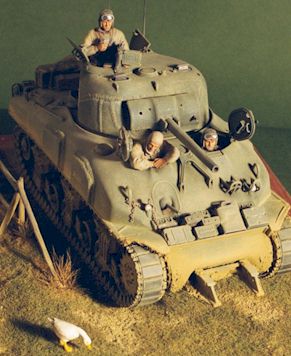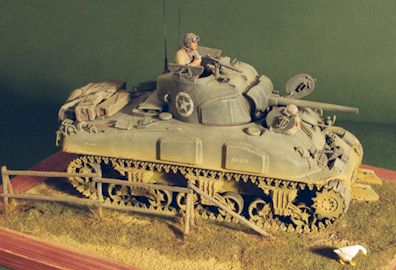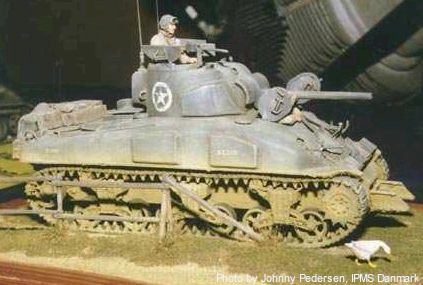Simple kit-bashing produces a cast hull Sherman tank
by Anders Isaksson
A legend in the history of American armored fighting vehicles, the Sherman medium tank was produced in larger numbers than any other tank during World War II. Although outgunned by its German counterparts, this drawback was compensated by the Sherman’s superb reliability, mobility and superior numbers. From its introduction in 1942 the Sherman saw action on every front throughout the war.
Construction
This model is the result of a combination of restoration and simple kit-bashing. I had a previously finished Italeri M32 Recovery Vehicle with a dull finish and a few missing parts that had been collecting dust for a while. I also had a resin 75 mm turret from Verlinden that had not been used yet. The idea came to combine the two components to make an M4A1 Sherman with a standard 75 mm gun. With a hull featuring the large drivers hatches this is certainly not the most common M4 type but still a few has been seen in pictures from Normandy.
After checking that I had all the parts needed to complete the M32 hull and running gear I started with adding the three pieces of armor plate to the hull sides. Originally these were welded to the hull to protect the ammunition stowage of the tank from direct hits. The plates have been fabricated from sheet styrene. To simulate the weld beads I rolled small amounts of Milliput in thin lengths and attached them along the edges of each plate. A small piece of styrene was used to make impressions in the still soft putty, simulating the rough texture of the weld beads. At this stage I sanded the entire hull to remove most of the old paintwork and smooth out any brush marks. The remaining small parts were then attached to the hull.
The Verlinden turret already featured the extra armor plating. However, the plates looked a bit too thick when compared with photos of real Shermans. Also the weld beads, although rough on the surface, looked a bit too straight and neat. I cut and sanded the plates to decrease their thickness. The weld beads were then cut away and replaced with new ones made of Milliput.
The turret was then completed with a commanders cupola from Tamiya’s M4A3 and other small details from the Italeri M32.
The final detail added was the Cullin Hedgerow Cutter. This was a device  mounted to the front of the tank to help driving through the thick hedges often found on the French countryside. Since it was a field modification not many hedgerow cutters looked alike, thus giving the modeller some artistic license. I scratchbuilt mine from sections of Plastruct I-beams and scrap pieces of plasticard and glued it to the nose plate of the hull.
mounted to the front of the tank to help driving through the thick hedges often found on the French countryside. Since it was a field modification not many hedgerow cutters looked alike, thus giving the modeller some artistic license. I scratchbuilt mine from sections of Plastruct I-beams and scrap pieces of plasticard and glued it to the nose plate of the hull.
Paint and decals
With every major subassembly complete the model was ready for painting. I airbrushed it using Model Master acrylic Olive Drab. When completely dry I applied a dark wash consisting of diluted Raw Umber oil color. I then dry-brushed with Humbrol Olive Drab mixed with a little white oil color to bring out detail.
The markings were taken from various Verlinden dry transfer sets. The numbers are not historically correct but I think the main point is that they are located in the correct position. The name Alice applied to the sides of the hull is entirely fictional.
The turret was now mated to the hull and the model was ready for weathering.
I begun by adding a mixture of water-based putty, white glue, some sand yellow watercolor, short pieces of elk hair (we’re in Sweden) and a little Static Grass to the underside of the hull and running gear, making sure not to cover too much of the detail. The result looks like dried cakes of mud with pieces of grass in it.
A heavily diluted mixture of sand tones was then roughly airbrushed to the lower portions of the model including the tracks.
Finally I added scratches and general ”wear and tear” using Humbrol Aluminium mixed with a little Raw Umber oil color.
Final Details
The tank was decorated with extra gear mainly from Italeri and Verlinden. On the engine plate I used a piece of fine silk to represent a piece of canvas fabric covering the gear. With all gear in place on the back plate I soaked the fabric in diluted white glue and carefully laid it on top, making a few wrinkles and creases. The dried fabric was painted a very dark mix of Humbrol Matt Black and Dark Earth followed by dry-brushing with Khaki Drill and light gray. Fine sewing thread was used to tie everything to the deck.
The crew comes from the excellent Dragon set titled U.S. Tank Crew (NW. Europe 1944). When I built this model back in 1996 this set happened to be released at the same time I started looking for figures to populate my tank. Since a complete tank crew made in resin is quite expensive I was happy that Dragon helped me out!
I used three of the four figures provided in the kit and they could be assembled, painted and installed in the tank without any modifications. A few minor adjustments had to be made to the arms of the right driver to achieve a good fit. The only additional detail was a few pieces of stretched sprue attached to the commanders helmet and handheld microphone to represent radio cords.
The Base
A picture frame was used for the base and the  basic profile of the ground built up using pieces of styrofoam. This was covered in plaster of Paris. The surface was further refined using a layer of… ground coffee (yet another local technology which explains the high coffee consumption in Sweden). With the ground work painted and static grass applied I fabricated a simple fence from strips of balsa wood. I made sure to make the fence look a bit worn and not too neat, avoiding square angles and completely straight strips of balsa.
basic profile of the ground built up using pieces of styrofoam. This was covered in plaster of Paris. The surface was further refined using a layer of… ground coffee (yet another local technology which explains the high coffee consumption in Sweden). With the ground work painted and static grass applied I fabricated a simple fence from strips of balsa wood. I made sure to make the fence look a bit worn and not too neat, avoiding square angles and completely straight strips of balsa.
To add a little interest to the display I also added a lone goose from the Tamiya Livestock set. I placed it on the base to make it look like the goose is catching the driver’s interest as his Sherman is making a short stop.
As usual I finished off the display by mounting every item to the base and make an overall application of sand colored pastel powder.
This article was originally published in IPMS Stockholm Magazine in September 2000.

